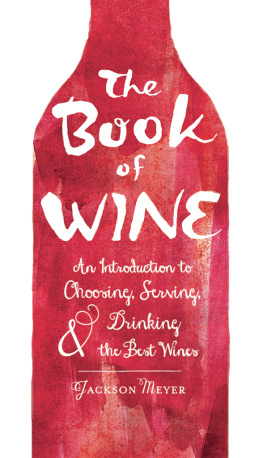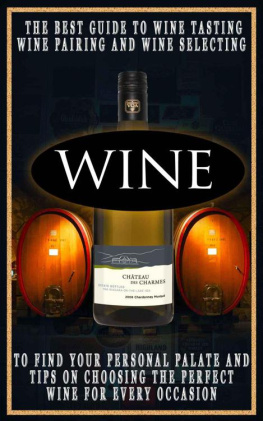Contents
Guide
The Book of Wine
An Introduction to Choosing, Serving, and Drinking the Best Wines
Jackson Meyer

Avon, Massachusetts
Contents
Introduction
Malbec. Shiraz. Prosecco. Youve enjoyed these wines at dinner parties and ordered them at restaurants. But now its time to learn more about these, and other, vintagesand prepare to soak in everything you need to know about todays most popular wines.
The Book of Wine opens the door to the deliciously complex world of wine and gives you the information you need to choose wines for any occasion; identify the nuances of different varietals by taste, smell, and region; and order and serve wine like an expert. In addition, youll find information on what to serve with the wine you bring home from your local winery or vintner, how to connect with vintners around the world, and how to explore wines from different regionsand different grapesto expand your palate.
Throughout the book, youll also find pricing information that will allow you to choose the best wine for the occasion, whether youre hosting a party for your friends or picking out a bottle to celebrate a special occasion:
- $ = $10$25
- $$ = $25$50
- $$$ = $50$100
- $$$$ = $100+
Keep in mind that, in all lists of recommended wines, prices and availability may vary.
So sit back, take a sip, and let The Book of Wine teach you everything you need to know about winefrom grape to glass.
PART 1
Wine 101
CHAPTER 1
A Brief History of Wine
The discovery of wine was probably an accident. It didnt have to be invented, because wine can happen all by itself. Its safe to assume that, way back, people learned to store their fruits of summer for the bleak winters ahead. More than likely, they put their grapes into a hollow in a rock, where nature took over, and fermentation turned the grapes into a bubbling liquid, which we now call wine.
Wine in the Ancient World
We may not know how humans were first introduced to wine, but we do know that people have been imbibing since at least 4000 B.C. , perhaps as far back as 6000 B.C. , and maybe even further back than that. Mesopotamia (Persia), near present-day Iran and Egyptthe endpoints of the Fertile Crescentseems to be the birthplace of ancient winemaking, and recent discoveries point to winemaking in China during the same period.
A Persian fable has it that an ancient king kept his beloved grapes in an earthen jar labeled poison. A discontented member of his harem drank juice from the jar in a suicide attempt, but instead of dying, she found her spirits quite rejuvenated. She shared the drink with her king, who took her into his favor and decreed that, henceforth, grapes would be allowed to ferment.
Ancient Persia was truly wine country. Not only did the Persians give toasts to their gods with wine, they also paid salaries in wine. Men earned ten to twenty quarts a month, and women earned ten. The grape varieties they used to make wine are believed to be the precursors of those used today.
The ancient Egyptians cultivated grapes and made wine in a surprisingly modern fashion. They developed the first arbors and pruning methods, and their grapes were stomped and fermented in large wooden vats. The wine was mostly sweet white wine, probably made from the grape now known as the Muscat of Alexandria. As a matter of respect to the gods, the Egyptians used wine in their funeral rites. Depending on the status held by the deceased, his body and belongings were anointed with wine prior to being entombed.
Situated between Egypt and Mesopotamia along the Fertile Crescent were the Phoenicians, who sailed the Mediterranean from what is now the coast of Lebanon. Thus the grapevineand winefound its way to Greece, Sicily, and north-central Italy.
During ancient times, everyone drank wine and beer, even children. Thats not as decadent as it might sound. Frankly, drinking the water was hazardous to ones health, and wine was a good substitute thirst quencher. If you sipped one of those old-style wines today, you would probably notice that it tastes more like vinegar with a hint of cider and possesses a fairly low alcohol content. It was certainly better than the water that was available. While wine was a staple of daily life, it was consumed mostly by the rich and powerful. Beer was the drink of the common folk.
Greeks Democratize Wine
Greeks embraced wine drinking more enthusiastically than any culture before them. Wine became a drink not just for the elite, but for everyone. It is said that of all the vessels Greeks used daily, more than half related to the consumption of wine. Wine was considered to be a gift from Dionysus, the patron god and symbol of wine, and it was used in religious rituals. Greek doctors, including Hippocrates, even prescribed it for their patients.
Wine Wisdom
Retsina is a traditional wine of Greece with a long history and the distinctive taste of pine resin. The taste that permeated the wine in ancient times became so accepted that long after resin-caulked containers were discontinued, chunks of resin were added to the wine during fermentation to reproduce the flavor. Most people who have tried retsinaGreeks includedsay its an acquired taste.
Greeks considered it barbaric to drink wine straight, so they diluted it in varying proportions with water. They also learned to add herbs and spices to mask spoilage. Greeks typically stored their wine in porous clay jugs, which had to be sealed to preserve the wine. They caulked the jugs with the resin of pine trees, which imparted its unique essence.
Wine was important to the economies of Greek cities. It was traded within Greece and exported throughout the Mediterranean world. As Greece began to colonize the western Mediterranean, the Greeks took their grapevines and winemaking technology with them.
Romans Advance Winemaking
The Roman Empire covered, at its greatest outward expansion, most of the Mediterranean lands and a good part of Europe. The Romans found grapes already under cultivation in many of their conquered lands, the wine culture having been widely distributed by their Greek and Phoenician predecessors. The Romans, too, loved wine and fostered its development throughout the empire.
By about 1000 B.C. , Romans were classifying grape varieties, charting ripening characteristics, identifying diseases, and increasing yields through irrigation and fertilization. They developed wooden barrels to store the wines in place of the skins and jars previously used. The Romans may have been the first to put wine into glass containers.
By the first century A.D. , Rome was awash with wine. Each person in the city of Rome drank on average half a liter each day. Winemaking techniques had spread from Italy to Spain, Germany, England, and France, and those regions developed their own vineyards. You could certainly call this the worlds first wine boom. Corner bars popped up all over cities such as Pompeii. The supply (or oversupply) of wine drove down the prices, so much so that Emperor Domitian ordered the great vineyards of France be uprooted to eliminate the competition of French wines with the local Italian wines. Fortunately, that order wasnt fully executed, and it was rescinded two centuries later.












